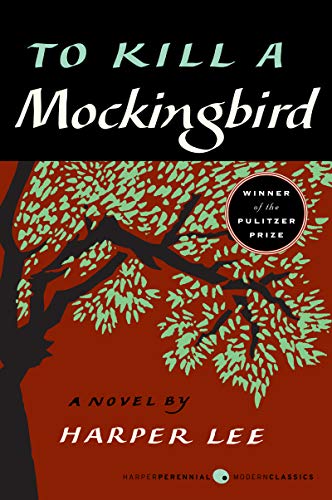Gather ’round, folks, as I share my humorous take on the timeless classic, To Kill a Mockingbird. This beloved book offers a roller coaster of emotions, and I’m here to give you my honest review. From Scout’s wide-eyed innocence to the eerie Southern Gothic vibes of Maycomb, there’s plenty to discuss. Plus, I’ll uncover Atticus Finch’s moral compass and dive into the gritty world of racial injustice. Grab your popcorn (or perhaps a mockingbird?), and enjoy the ride!
In a Nutshell
In To Kill a Mockingbird, Harper Lee weaves a tale that’s as charming as it is thought-provoking. A staple of Southern Gothic fiction, this book takes us to Maycomb, Alabama—a town buzzing with small-town charm and shadowed by deep-seated prejudice.
Our young narrator, Scout Finch, learns about life, justice, and morality through her father, Atticus Finch, a lawyer defending a black man wrongfully accused of a horrible crime. Lee brilliantly explores themes of racial injustice, moral growth, and compassion without letting the story’s intensity weigh down the delightful moments of childhood innocence. If you’re into heartwarming stories with a sprinkle of humor and a dash of suspense, this classic is just the ticket!
Exploring Scout’s Childhood Innocence in Harper Lee’s Masterpiece
Scout Finch, the pint-sized heroine of Harper Lee’s To Kill a Mockingbird, is like a breath of fresh air on a scorching southern day. Her innocence and lack of filtered adult bias paint a picture of childhood idealism that many of us can relate to. But man, does she remind me of my 6-year-old nephew, Timmy. He once asked why the sky isn’t pink. Like Timmy, Scout’s innocence often leads to amusingly insightful questions, causing the grown-ups around her to pause and think.
Scout approaches the world without a trace of pretension. When she brings Walter Cunningham home for lunch, she’s genuinely baffled by the social hierarchies that prevent her father from intervening in his family’s financial struggles. This interaction, to me, highlights her pure-hearted view of equality. Her curious nature and willingness to question everything are like my buddy Jake’s insatiable need to know the ending of every TV show before watching it. But while Jake’s habit is annoying, Scout’s questions open the door to critical conversations about justice and morality.
What strikes me about Scout is her ability to see people for who they truly are, not for the labels society places upon them. This is as refreshing as a lemonade on a hot afternoon. Even when faced with Maycomb’s ugly prejudices, Scout clings to her sense of fairness and truth. Her interactions with Boo Radley showcase her belief in giving everyone a chance, a trait many adults, frankly, could learn from.
In the next chapter, get ready for a deep dive into the stormy seas of racial injustice and prejudice in Maycomb. Buckle up, it’s gonna be a bumpy ride.
Racial Injustice and Prejudice in ‘To Kill a Mockingbird’
Picture this: you’re back in the 1930s, in a town where racial injustice hangs heavier than a mosquito-laden summer evening in Maycomb, Alabama. In Harper Lee’s ‘To Kill a Mockingbird’, the story tears off the rose-colored glasses and lays bare the raw and unfiltered prejudice of the era. I’ve been in shoes where assumptions were made based on nothing more than a glance. But Maycomb takes it to another level. You know things are bad when a dog’s bark might be more trustworthy than a jury’s verdict.
Lee masterfully captures the ugly essence of racial bias. Remember Tom Robinson, the African American wrongly accused of a crime he didn’t commit? Despite every fiber of evidence pointing to his innocence, the jury’s prejudice looms like a stubborn raincloud refusing to scatter. I once watched my buddy – let’s call him Ted – make a mess out of a game night because he was convinced red pieces had it out for him. The irony wasn’t lost on me.
‘To Kill a Mockingbird’ is so much more than its pages. It’s a mirror, reflecting the prejudice hidden under the respectable facades of society. Even today, its truth resonates in unexpected places, like when the vending machine spits out your money or when someone cuts you in line and pretends they didn’t notice. It hits home.
But for every icy glance and whispered slur, there’s a voice of reason, a lighthouse guiding ships through the storm. In our next section, we’ll chat about Atticus Finch, whose moral guidance stands tall like a stubborn oak tree refusing to bow to the wind.
“`html
Unwavering Guidance: Atticus Finch’s Moral Compass
I remember reading To Kill a Mockingbird and being struck by Atticus Finch, who seemed like the dad everybody wanted. The guy radiates integrity and stays calm, even when everyone else loses their marbles. That time I tried to coach my nephew’s soccer team, I channeled my inner Atticus. Spoiler alert: My team still lost every game, but hey, it’s the effort that counts, right?
Atticus shines as a beacon of morality in a world filled with chaos and prejudice. In the sleepy town of Maycomb, where about as much excitement happens as in a library during naptime, Atticus stands up against the madness of racial bias. He defends Tom Robinson, an African American man falsely accused of a crime, with the kind of dedication I reserve for finishing an entire pizza by myself.
One of Atticus’s most memorable lessons to his kids, Scout and Jem, is about seeing things from other’s perspectives. He famously says you never really understand a person until you climb into his skin and walk around in it. I tried this metaphor once, but it didn’t work out as planned—turns out, walking around in someone else’s shoes is just borrowing them without permission.
While Atticus’s guidance helps his children navigate the moral landscape, he also teaches readers a thing or two. Like, maybe don’t judge your neighbor unless you’ve tried their potato salad.
Stay tuned for the next section as we wander into the Southern Gothic atmosphere, where you’ll find more eerie mishaps than my last camping trip.
“`
Exploring the Southern Gothic Atmosphere in ‘To Kill a Mockingbird’
If you’ve ever walked through a Southern town at night, you’ll know there’s a spooky feeling in the air—like the ghosts of history shake the trees. Harper Lee’s ‘To Kill a Mockingbird’ captures that eerie Southern Gothic atmosphere perfectly. As a kid, I thought ghost stories were just for campfires. But this book proves that the scariest stories might just be found in your own backyard.
The way Harper Lee paints Maycomb is like looking through a time-worn picture frame. You can almost feel the humidity and hear the cicadas buzzing. The old Radley house, where Boo Radley becomes an urban legend among the kids, feels as creepy as that one house on your street no one dared to trick-or-treat. Boo Radley’s mysterious presence just adds to that spine-tingling vibe.
What Lee does especially well is mix this dark setting with real-life issues, like the deep-rooted prejudices that lurk in the shadows of Maycomb. Lee has a knack for making the atmosphere reflect the townsfolk’s hidden fears and attitudes, painting a vivid picture of a society that’s both stuck in its ways and on the brink of change. She pulls back the curtain on Southern charm to show it’s not all sweet tea and pecan pie.
Do I recommend diving into this book for its Southern Gothic flair? Absolutely! Grab your flashlight, because ‘To Kill a Mockingbird’ will have you exploring the mysterious nooks and crannies of Southern life like never before.
Conclusion
Well folks, that wraps up our chat about ‘To Kill a Mockingbird’! This classic is a rollercoaster of emotions, with Scout’s innocence, the Southern Gothic vibe, and Atticus’s strong moral compass leading the way. Sure, it’s got a few dusty corners, but ultimately, it’s a page-turner with heart. It’s like that creaky old house on your block—mysterious, a bit intimidating, but worth a closer look. If you’re diving into the world of Maycomb, be ready to laugh, learn, and maybe even shed a tear or two. So grab a comfy chair, your favorite drink, and enjoy the ride!


